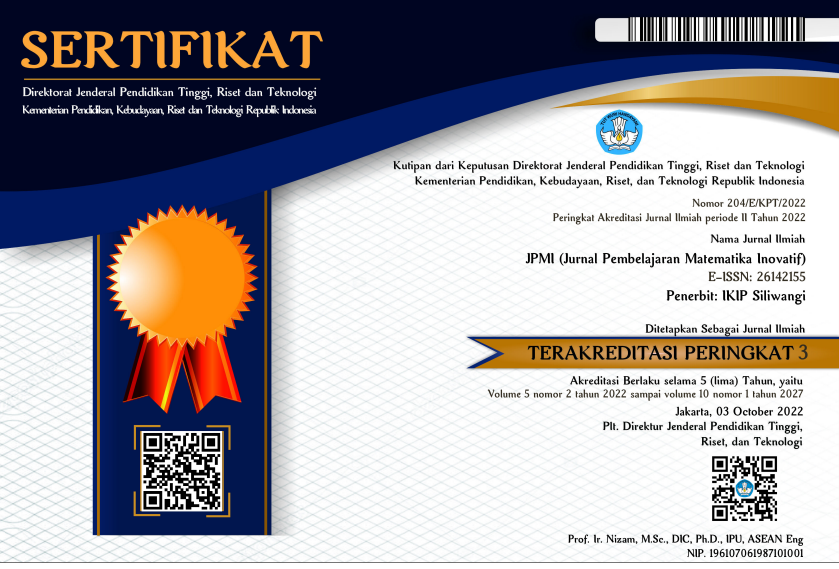EKSPLORASI ETNOMATEMATIKA RUMAH PANGGUNG BETAWI SI PITUNG DALAM PANDANGAN AKTIVITAS FUNDAMENTAL MATEMATIS BISHOP
DOI:
https://doi.org/10.22460/jpmi.v%25vi%25i.p%25pKeywords:
Ethnomathematics, Betawi Stage House, Bishop Universal Mathematical Activities, Pitung’sAbstract
References
Alangui, W. V. (2010). STONE WALLS and WATER FLOWS: Interrogating Cultural Practice and Mathematics. The University of Auckland.
Castles, L. (1967). The Ethnic Profile of Djakarta. Indonesia Journal, 3(1), 152–204.
D’Ambrosio, U. (2002). Etnomatemática: elo entre as tradições e a modernidade. Autêntica.
Dirgantoro, K. P. S. (2018). Kompetensi Guru Matematika Dalam Mengembangkan Kompetensi Matematis Siswa. Scholaria: Jurnal Pendidikan Dan Kebudayaan, 8(2), 157–166. https://doi.org/10.24246/j.js.2018.v8.i2.p157-166
Garna, Y. K. (2009). Metoda penelitian kualitatif (2nd ed.). Judistira Foundation dan Primaco Akademika.
Gunawan, F. I. (2019). Kajian Etnomatematika Serta Analisis Aktivitas Fundamental Matematis Menurut Bishop Pada Industri Kain Cual Bangka Belitung [Universitas Sanata Dharma]. https://repository.usd.ac.id/36257/2/181442001_full.pdf
Iryani, E. (2014). Makna Budaya Dalam Pendidikan. Jurnal Ilmiah Universitas Batanghari Jambi, 14(2), 110–112.
Moleong, L. J., & Surjaman, T. (1989). Metodologi penelitian kualitatif (1st ed.). Remadja Karya.
Muktiono, A. (2020). Mungungkap Pesan Semiotik Arsitektur Rumah Si Pitung. Ikra-Ith Teknologi, 4(1), 32–41.
Prijana, & Yanto, A. (2018). Metode Penelitian Kualitatif (H. S. . Massie (ed.); 1st ed.). CV. Pustaka Utama.
Putra, Y. M. P. (2019). Melahirkan Kembali Budaya Betawi. Republika.Co.Id.
Salim, P. (2015). Memaknai Arsitektur dan Ragam Hias pada Rumah Khas Betawi di Jakarta sebagai Upaya Pelestarian Budaya Bangsa. Humaniora, 6(3), 395–402. https://doi.org/10.21512/humaniora.v6i3.3365
Sari, W. A. (2018). Kulturasi Pada Fasad Rumah Betawi Studi Kasus : Rumah Si Pitung di Marunda. Jurnal Ilmiah Desain & Konstruksi, 17(1), 11–20. https://doi.org/10.35760/dk.2018.v17i1.1922
Swadarma, D., & Aryanto, Y. (2013). Rumah Etnik Betawi (I. Puspitasari (ed.); 1st ed.). Griya Kreasi, Depok. https://books.google.co.id/books?id=NFa9BgAAQBAJ
Tandililing, P. (2015). Etnomatematika Toraja (Eksplorasi Geometri Budaya Toraja). Jurnal Imiah Matematika Dan Pembelajarannya, 1(2), 47–57.
Utari, D. R., Wardana, M. Y. S., & Damayani, A. T. (2019). Analisis Kesulitan Belajar Matematika dalam Menyelesaikan Soal Cerita. Jurnal Ilmiah Sekolah Dasar, 3(4), 534–540.

















